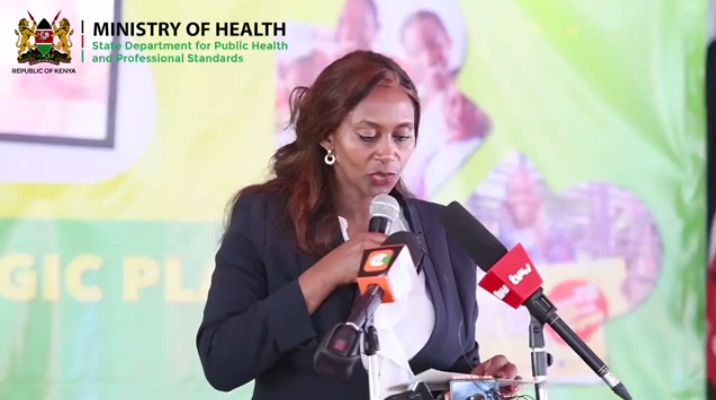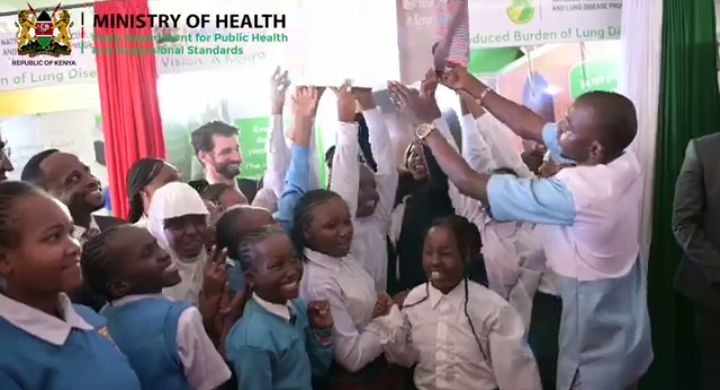
Ministry of Health Launches Five Years Strategic Plan to deal with Tuberculosis, Leprosy and lung health
The PS for Health Ms Mary Muriuki urges Kenyans to support government’s agenda so as to see a country free from curable diseases
The strategic plan has seen other partners like USAID, TB Accelerated Response and Care as well as PEPFAR and centre for Health Solutions
The Principal Secretary for Public Health and Professional Standards Mrs Mary Muthoni has implored on Kenyans to support The Social Health Insurance Fund (SHIF), Policy being fronted by the Kenya Kwanza Administration.
This is because it will treat all chronic diseases unlike the current National Health Insurance Fund schemes which does not cater for chronic illness and sometimes paying for only patient’s bed bills leaving the huge burden with families to struggle
The (SHIF) one of President William Ruto’s flagship projects, is seeking to provide affordable healthcare to all Kenyans. SHIF replaces the 57-year-old National Health Insurance Fund (NHIF).
Speaking during the unveiling of National Strategic Plan for Tuberculosis, Leprosy and Lung Health on Monday 22nd January, Mrs Muriuki reminisced Kenyans that the scheme will fund diseases including cancer, diabetes and heart diseases which has seen many be flown to Indian Hospitals
According to PS, President William Ruto’s agenda on Health is to see the implementation of Universal Health Coverage to all citizens including the elderly so as to boost country’s economy by dealing with deaths related to curable diseases
The five-year (2024-28) strategic plan aims to ensure quality care for TB, leprosy and lung diseases for all Kenyans.
The PS said that the ministry is committed to further reducing the cases of TB reported in a year.
“In 2022, Kenya reported a total of 90,560 drug-sensitive TB cases, an increase compared to the 77,854 cases reported in 2021,” she said.
The strategic plan also calls for strengthening provision of integrated TB/HIV and other co-morbidities services at sub-national levels by 2028.
On leprosy interventions, the plan envisions reduction of number of people diagnosed with multibacillary leprosy amongst new cases up from 95 percent to below 25 percent by 2028.
The PS went further to caution medical professionals against cases of misdiagnosis which have lead to deaths in some cases where patients suffered from tuberculosis.
Muriuki said that the ministry is working with the CDC, WHO and USAID to achieve a TB-free Kenya.
She said the plan will be an inclusive guide that will be used in the fight to end TB in Kenya.
The PS also called for other ministries to partner with MoH to address TB.
The key objective of this NSP is to move closer to the global target of eliminating TB by 2030, through a combination of quality prevention, diagnostic and treatment services for TB, Leprosy and Lung diseases. She added that community health workers will play a pivotal role in screening TB.

She however noted that despite an increase of case detection rates misdiagnosis of TB cases is still a challenge in TB elimination goal.
She assured Kenyans that the ministry is working to empower those affected by the disease, especially in rural areas.
The launch also calls to curb misinformation around Tuberculosis.
Data from the Ministry of Health in November 2023, shows case finding and treatment have improved after a sharp drop in 2020.
Last year, 90,841 people with TB were identified, out of the estimated 112,000
In 2020 the identified cases had dropped to 72,943 which means more people with TB remained untreated, potentially infecting others.
The figures were released by the National Tuberculosis, Leprosy and Lung Disease Programme (NTLLDP).
The number of people with drug-resistant TB dropped from 957 in 2020 to 756 last year.
It also gives direction of how the country will increase treatment coverage for Drug resistant TB (DS TB) from 63 percent to 80 percent and multi-drug resistance TB case detection rate from 69 percent to 80 percent by 2028.

